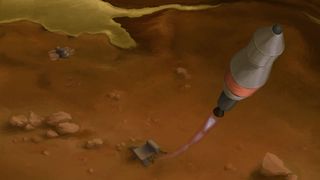Scientists ponder how to get samples from Saturn's weird moon Titan
Saturn's moon Titan is a tantalizing world, how difficult would it be to bring a piece of it to Earth?

A sample-return mission to Saturn's moon Titan could discover unexpected forms of life and bring back chemical compounds that cannot be found on Earth. A team of NASA researchers is designing a mission concept that would use Titan's lakes of methane as a source of fuel to power the spacecraft’s trip back home.
Saturn's moon Titan is a mysterious world. The second largest moon in the solar system, Titan is larger than the planet Mercury and, next to Earth, is the only place in the solar system with flowing rivers of liquid and lakes on the surface. Except these rivers and lakes hold not water but hydrocarbons, such as methane. But Titan also has water — an entire ocean of it, under the moon's frozen surface. Titan also has an atmosphere rich in nitrogen, just like our planet.
A team of engineers from the NASA Glenn Research Center in Cleveland has recently received a $125,000 NASA Innovative Advanced Concepts (NIAC) grant to look into the feasibility of bringing a sample of material from this intriguing world to Earth. The NIAC program specializes in funding technology that is nowhere near ready to launch, but offers intriguing benefits for future exploration missions.
The good news is that to land on Titan would be much easier than the seven minutes of terror of a landing on Mars. Titan's atmosphere is six times as thick as the atmosphere of Earth, and would provide enough drag to slow down a lander for a soft touchdown even without landing rockets.
"We expect landing on Titan to be relatively easy," Steven Oleson, head of the Compass Lab at Glenn, which conducts conceptual spacecraft design for NASA, said in a statement. "Titan has a thick atmosphere of nitrogen — 1.5 times the atmospheric pressure of Earth — which can slow the lander's velocity with an aeroshell and a parachute for a soft landing, just like astronauts returning to Earth."
The global scientific community got the first detailed look at Titan thanks to the Cassini mission, which orbited Saturn between 2004 and 2017. During that time, the spacecraft performed over a hundred flybys of the planet's largest moon. The strange world that Cassini uncovered sparked even more scientific curiosity.
Related: Dazzling Views Show Saturn Moon Titan's Surface Like Never Before
Get the Space.com Newsletter
Breaking space news, the latest updates on rocket launches, skywatching events and more!
Scientists believe that Titan’s subsurface water ocean could host life similar to that found in the deepest regions of Earth's ocean. Despite freezing surface temperatures of minus 290 degrees Fahrenheit (minus 179 degrees Celsius) and up to 50% higher air pressure than on Earth, the surface lakes of hydrocarbons might not be lifeless either. The life they might harbor could be very different from that on Earth, governed by the carbon-rich chemistry of its surroundings.
Moreover, scientists studying Titan's surface and atmosphere have found a class of chemical compounds called tholins, which can't be found anywhere on Earth. These compounds, scientists believe, might have played a key role in the emergence of life on the young Earth billions of years ago.
There would be plenty to look for in a sample from Titan. And with the landing out of the way, the next big challenge would be to get the sample up to space, on its way back to Earth. For that, the Glenn team envisions, the surface lakes of methane will come in handy.
"Producing rocket fuel on Titan wouldn't require chemical processing — you just need a pipe and a pump," said Oleson. "The methane is already in a liquid state, so it's ready to go."
The Compass Lab team will now investigate how to effectively produce liquid oxygen, to enable the fuel to burn. One option is to melt Titan's "rocks" of water ice with a nuclear heat source and then split the water.
Although the sample-return concept may never fly, Titan can expect a robotic visitor soon. Dragonfly is an eight-bladed rotorcraft scheduled to begin the eight-year journey to the Saturn system in 2027.
Follow Tereza Pultarova on Twitter @TerezaPultarova. Follow us on Twitter @Spacedotcom and on Facebook.
Join our Space Forums to keep talking space on the latest missions, night sky and more! And if you have a news tip, correction or comment, let us know at: community@space.com.

Tereza is a London-based science and technology journalist, aspiring fiction writer and amateur gymnast. Originally from Prague, the Czech Republic, she spent the first seven years of her career working as a reporter, script-writer and presenter for various TV programmes of the Czech Public Service Television. She later took a career break to pursue further education and added a Master's in Science from the International Space University, France, to her Bachelor's in Journalism and Master's in Cultural Anthropology from Prague's Charles University. She worked as a reporter at the Engineering and Technology magazine, freelanced for a range of publications including Live Science, Space.com, Professional Engineering, Via Satellite and Space News and served as a maternity cover science editor at the European Space Agency.
